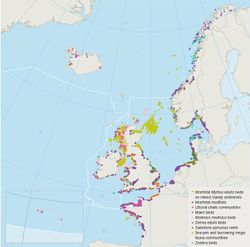Biogenic reefs of Europe and temporal variability
European-scale distribution of biogenic reefs
Biogenic reefs can be described as hard compact structures created by the activity of living organisms. They do not share a uniform structure and are found at variable spatial scales. Dense colonies of several species are widely considered to be reef in Europe. Only four of these species are described in this report due to their contribution to sediment entrainment, bed stability and potential wave energy attenuation, these are: Sabellaria alveolata, Sabellaria spinulosa, Modiolus modiolus and Mytilus edulis. Many biogenic reef habitats are currently threatened and/or are in decline in Europe as a result of various natural and anthropogenic pressures (OSPAR 2010 Cite error: Invalid <ref> tag;
invalid names, e.g. too many). Figure 1 illustrates the distribution of some biogenic reef habitats which are currently in decline around the coast of Europe.
Sabellaria spinulosa
Sabellaria spinulosa reefs are known from all European coasts, except the Baltic and the waters of the Kattegat and Skagerrak, but are typically limited to areas with very high levels of suspended sediment (OSPAR 2010 Cite error: Invalid <ref> tag;
invalid names, e.g. too many, Fig. 2.20). In the UK aggregations of S. spinulosa are reported to occur at a number of locations around the British Isles (Holt et al., 1998; Davies et al., 2009). Perhaps the best known example of an S. spinulosa reef in the UK is found in the mouth of the Wash (east coast of England), where reefs are elevated above the seafloor and have been found to extend over hundreds of square meters within the Norfolk Coast SAC (Foster‐Smith & Hendrick 2003). Relatively few records have been found in Scotland (Figure 1). Not all of these aggregations could be described as “reefs”, for instance where the species may only form superficial crusts on mixed substrata. On the German coast, intertidal and subtidal reefs have been reported from the Wadden Sea (Berghahn & Vorberg, 1993) and from the southern North Sea where Linke (1951) reported reefs up to 60 cm thick, 8m wide and 60 m long. S. spinulosa has also been reported from the French coast, but without precise locations (Holt et al., 1998).
Examples
based on
